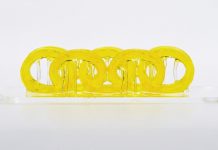
In simple terms, imagine a diamond not just as a beautiful gem but as a key player in the future of technology. Scientists have been studying diamonds closely, not for their sparkle, but for something called “color centers.”
These are tiny defects in diamonds that, believe it or not, could revolutionize how we communicate and compute in the future.
At the heart of this research is a team from Ulm University in Germany. They’ve been working with a special kind of defect found in diamonds, focusing on one called the Germanium vacancy (GeV) center.
This might sound complicated, but it’s essentially a tiny imperfection in the diamond that has some very useful properties for what’s known as quantum technology – a cutting-edge field that could one day make our computers and communication methods far more powerful than they are today.
Katharina Senkalla, one of the researchers, explains that while diamonds are well-known for their beauty, they’re also becoming famous in the scientific world for these color centers.
The most well-known of these has been the nitrogen-vacancy center, but the GeV and others are starting to get attention because they can emit light in a very specific and useful way. This makes them perfect for creating quantum networks, which are like the internet but for quantum computers.
Quantum networks need something called a quantum memory, which is a way to store information in the state of a quantum system. It’s a bit like the memory in your computer or phone, but far more advanced.
The team at Ulm University has created a quantum memory using the GeV center in a diamond, and it’s turned out to be really good at its job. They’ve managed to make this memory work for more than 20 milliseconds, which might not sound like much, but in the fast-paced world of quantum computing, it’s a big deal.
To make their discovery, the team had to overcome a lot of challenges. One of the biggest was dealing with phonons – tiny vibrations that can mess up the quantum information stored in the diamond.
They used a special refrigerator to cool down the diamond to very low temperatures, which helps to keep these vibrations under control.
They also had to figure out how to protect the quantum information from other kinds of noise and interference. They did this by using carefully timed microwave pulses, a bit like how noise-canceling headphones work to block out unwanted sound.
Their work is really exciting because it shows that these diamond defects can be used to create quantum memories that are both effective and durable.
This could be a big step forward for quantum technology, making it possible to build networks that can handle quantum information over long distances.
The researchers are now looking at how to incorporate their findings into real quantum networks. They’re building experimental setups in Ulm, aiming to turn it into a hub for quantum technology research in Germany.
Looking ahead, the team plans to keep pushing the boundaries of what’s possible with quantum technology. They’re exploring how to increase the rate at which photons (particles of light) can be produced and entangled, which is key for quantum communication.
They’re also working on ways to correct errors in quantum information, a critical step towards building reliable quantum computers.
In short, the work being done with diamonds at Ulm University is not just about making something that looks nice. It’s about building the foundations for a future where quantum technology changes the way we live, work, and communicate.
The journey is still at its beginning, but the potential is as bright as a diamond’s sparkle.
The research findings can be found in Physical Review Letters.
Copyright © 2024 Knowridge Science Report. All rights reserved.



